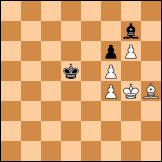Wednesday, September 24, 2008
Forcing?
I was looking through Charles Hertan's new book Forcing Chess Moves in a bookstore last weekend. It looks pretty good, though I haven't bought it yet. But here's something from the introduction that I don't understand.
On page 12, Hertan gives us a definition:
A forcing move is a move which limits the opponent's options. Nothing more or less.
OK, I'll buy that. On page 15, he gives this example, from Hertan-Kelleher, Cambridge 1994:
Black to play
What's a forcing move?
Hertan explains that Black played 1...Ke4 and lost, and also gives a White win against the "waiting move" 1...Kd4. Finally, he shows that Black has a draw after 1...Kd6! I didn't copy his analysis, but it seemed convincing enough.
Hertan tells us that Kelleher said that he never considered ...Kd6 because it seemed "too passive", and says that this is an example of the "human bias" we need to overcome:
While a computer would have used brute force caclulation to find the draw, a failed to even consider the strongest forcing move due to human bias!(emphasis in the original; I've used bold where the book uses small caps).
What what what?! How is ...Kd6 a forcing move? What options of White's does it limit? None I can see.
I think this position is more an exampe of using "process of elimination" to find te right move. The forcing ...Ke4 doesn't work, ....Kd4 loses as well, moving the Bishop is useless--try dropping the King back. But if I'm supposed to look at ...Kd6 because it's "forcing", then is there any move in any position that isn't "forcing"?